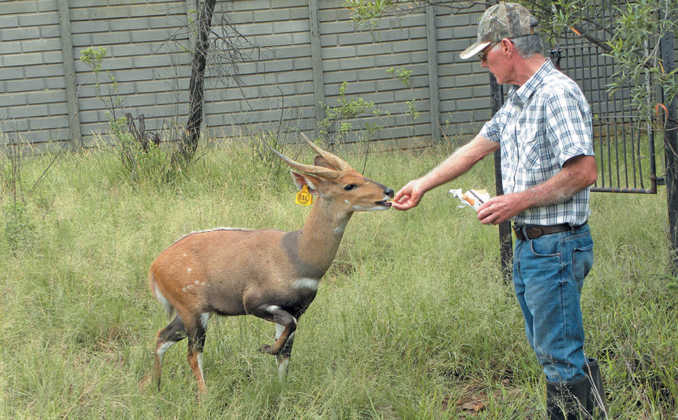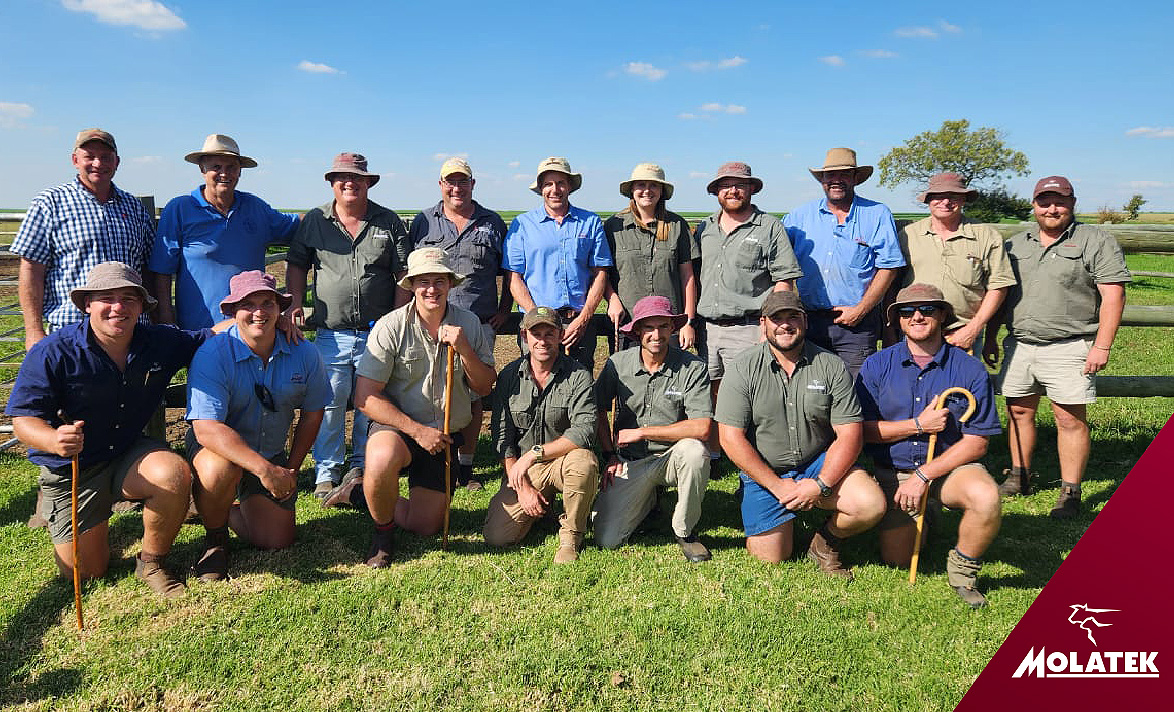A Step-by-step Guide to Intensive Bushbuck Breeding
Werner Nel of Bosbok R514 Breeders near Hartbeespoort in North West started breeding bushbuck in 2010. In time, the project expanded to the point where it became necessary to isolate young rams in separate camps to monitor, document and evaluate their growth rate.

When starting out in his bushbuck breeding enterprise in 2010, Werner Nel of Bosbok R514 Breeders set himself several goals to ensure success.
The first was to select animals sourced from various geographical regions to ensure a diverse gene pool.
The second was to select for horn length to breed superior rams, as hunters selectively hunt rams with long horns (19†plus), resulting in a scarcity of such rams in wild bushbuck populations.
The enterprise, located near Hartbeespoort in North West, has made considerable progress during the past seven years. Young breeding rams in the 15-month-old breeding group now show promise of reaching trophy status by three years of age, or even before.
Horn growth
Werner explains that in his search for breeding rams with horns of at least 17″, tooth inspection showed that some of these rams offered for sale at a claimed age of five to eight years, no longer had functionally effective teeth, proving that they were, in fact, considerably older.
For this reason, Bosbok R514’s trials also monitor the rate of horn growth in young rams.
In one trial, a promising young ram (E1L, born on 27 October 2014), was isolated in a small camp of about 500m2 at the age of 12 months, specifically to establish the effect of an extremely limited natural habitat on horn growth and body development.
The animal received a balanced diet ad lib and his horn length was measured monthly from the age of 12 months to 24 months, and thereafter every six months.
On 27 October 2016, at two years of age and with horns measuring 12″, the ram was transferred to a larger camp, but still isolated from ewes. At the current growth rate, E1L’s horns should reach 18″ at the age of three years.
This trial put paid to the long-held assumption that a bushbuck ram reached trophy status only at the age of five years. However, as the trial was conducted under favourable controlled conditions, the results may not necessarily apply to a free-living population in less than ideal conditions.
“We found that the natural habitat plays a less important role in the physical development and horn growth of bushbuck, especially when a steady supply of balanced nutrition is available” says Werner.
Using the rate of horn growth as a selection criterion for rams in a breeding programme from a relatively early age has often proved disappointing, however. The ram, V2P, born on 13 January 2013, was the only breeding ram used for nearly two years up to 31 August 2016. Afterwards, with horns measuring about 12″, he was placed in isolation.
Unfortunately, there was a lack of knowledge and baseline data to show this exceptional ram’s potential of reaching trophy status within an acceptable period. Werner therefore approached well-known bushveld game farmer, Pieter Lampbrecht, for advice.
In his opinion, the ram “still had a lot of go in him”. His verdict led to an exciting experiment which, within four months, yielded significant statistical data: at the rate of horn growth observed, the ram reached trophy status by the end of April this year.
His youthful age (four years), and excellent nutritional status during a two-year breeding programme, largely contributed to eliminating the handicap in horn growth.
Valuable insights
Werner shares some observations from his breeding programme:
- When not competing with other game species in the same camp, bushbuck yield excellent dividends. They thrive in their own mini camps (2 000m2 to 5 000m2), in which they can be managed and supervised daily.
- In winter, and particularly during a drought, the best habitat can be deficient in nutrition. Supplementary feed and lick should, therefore, be provided under cover, but it is not necessary to erect an expensive structure.
- A ratio of one young breeding ram to 10 to 15 ewes in the camp works well. Under favourable conditions, a bushbuck ewe can lamb every eight months throughout the year.
- In a small camp and with the correct human contact, a bushbuck becomes very tame. It can be fed by hand and the udder of a ewe can be palpated for signs of swelling and gestation without immobilising the animal.
- Young rams should be removed from the breeding ram’s camp timeously. The breeding ram guards the ewe for up to five days before she is ready for mating. During the run-up to mating, he should not be stressed or irritated unnecessarily. For this reason, a teaser ram is not a good idea.
- A breeder should source high-quality ewes sired by trophy rams. Before purchase, the jaws and teeth of a ewe should be inspected. The breeder should learn to interpret tooth wear, and identify extreme cases. The condition of the cheekbones should also be noted; these tend to become prominent in the case of older, starved or emaciated animals.
- Ideally, a breeder should source tame bushbuck already adapted to small camps. When the habitat deteriorates in winter and during extended drought periods, supplementary feed should be provided. Two young ewes and one young ram will require a total of about 3kg per day. Self-mixing feed eliminates the need for game pellets.
“From the start, buy high-quality breeding stock that will provide long-term dividends,” advises Werner.
“Expand gradually, read the market continually, and concentrate on game species that will remain scarce and in demand in a declining market.”
With the correct marketing strategy, he adds, a superior, well cared-for young bushbuck trophy ram with 18″ horns could sell for considerably more than R100 000.
Breeding Tips
- A 50“ watering trough with a visible bottom is ideal for a bushbuck mini camp. Replace the water weekly and clean the trough regularly.
- A properly cared-for bushbuck ewe can easily reach 15 years of age in captivity and produce at least 18 lambs. In a stressed habitat, she will eat supplementary feed worth about R15 000 during this period.
- A high-quality ewe serviced by a champion trophy ram with 19″ horns can sell for up to R85 000 at auction. DNA-based proof of paternity will be required to realise a price like this, however.
- An in-lamb ewe with lamb at foot needs supplementary feed. As birds compete for the feed, place a small amount of feed in each bin early in the morning, cover it with a sack, and anchor it in position with stones, but leave about 50mm on one side between the sack and the rim of the bin so that the ewe can see the feed.
- As a newborn lamb initially suckles every six hours, feeding the ewe only in the evening will not provide all its initial needs, which would be to the detriment of both.
- Evaluate the feed mix periodically to prevent the ewe becoming visibly fat. Winter and summer feed mixes should each have its own recipe, and this may also vary from habitat to habitat, so a one-for-all approach is not advisable.
- Bushbuck cannot thrive on grass alone. They browse extensively on, amongst others, the leaves of the num-num (Carissa spp.) from May to October, and also favour the dropped leaves of buffalo thorn (Ziziphus mucronata), the fruit of the marula (Sclerocarea birrea), and the young shoots of acacia thorn trees.
- An impenetrable fence, readily visible to game, especially at night, limits losses and ensures breeding success.
- Apply rotational grazing and prevent undesirable invader plants and inedible weeds from encroaching the camp. Allowing a camp to recover every year produces new seed that counters the effect of eventual long-term overgrazing.
- A consistently well-fed and managed ram has a breeding life of at least 10 years.
- Neglecting the diet of either a ram or ewe will, in time, render it unfit to breed.
- All horn measurements are stated in inches (1″ = 2,54cm), as per convention in the game breeding and trophy industries.
Email bosbokr514@gmail.com.
Source:Farmer’s Weekly


